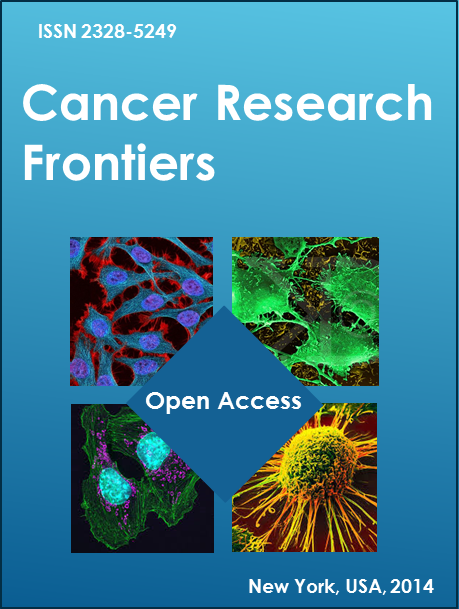Abstract _ Full Text (HTML) _ Full Text (PDF)
Research Article
Cancer Research Frontiers. 2017; 3(1): 204-214. doi: 10.17980/2017.204
Patterns of Care and Outcomes in Early Stage Neuroendocrine Carcinoma of the Uterine Cervix
Alison K. Yoder1, Shraddha M. Dalwadi2, Clark M. Dorman3, Tracilyn R. Hall4,5, Matthew L. Anderson4,5, Michelle S. Ludwig 2,5*
1Baylor College of Medicine, Houston, TX, USA
2Department of Radiation Oncology, Baylor College of Medicine
3University of Texas Health Science Center at Houston McGovern Medical School, Houston, TX, USA
4Department of Obstetrics & Gynecology, Baylor College of Medicine
5Dan L. Duncan Comprehensive Cancer Center, Baylor College of Medicine
*Corresponding author: Michelle S. Ludwig, MD, MPH, PhD. Department of Radiation Oncology, One Baylor Plaza, MS BCM711, Houston, Texas 77030. (p); (f). Email:
Citation: Alison Yoder, et al. Patterns of Care and Outcomes in Early Stage Neuroendocrine Carcinoma of the Uterine Cervix. Cancer Research Frontiers. 2017; 3(1): 204-214. doi: 10.17980/2017.204
Copyright: @ 2017 Alison Yoder, et al. This is an open-access article distributed under the terms of the Creative Commons Attribution License, which permits unrestricted use, distribution, and reproduction in any medium, provided the original author and source are credited.
Competing Interests: The authors declare no competing financial interests.
Received June 19, 2018; Revised Aug 18, 2018; Accepted Aug 27, 2018. Published Sept 7, 2018
Abstract:
Objective: Neuroendocrine carcinoma (NEC) is a rare form of cervical cancer associated with poor outcomes. We aimed to examine whether the addition of chemotherapy or radiation to hysterectomy for treatment of early stage NEC improved patient survival.
Methods/Materials: All women in the National Cancer Database diagnosed with early stage (FIGO I-IIA) NEC were identified. Coded patient demographics, tumor characteristics, and data regarding treatment were abstracted. Cox univariate and multivariate survival analyses were performed using SPSS Version 24.0.
Results: A total of 104 subjects with stage I-IIA NEC whose treatment included hysterectomy were identified. Mean age of these subjects was 41 + 14.1 years and median follow-up length was 47 months. Nearly half of subjects (n=50, 48.1%) were treated with a combination of hysterectomy, radiation, and chemotherapy, while fewer women underwent hysterectomy and chemotherapy (n=33, 31.7%), hysterectomy alone (n=20, 19.2%) or hysterectomy followed by radiation (n=1, 1.0%). In univariate analysis lower stage, Caucasian or Hispanic race/ethnicity, lack of lymph metastases, and negative surgical margins were associated with improved overall survival (p<0.05). Tumor stage, lymph node involvement, and race remained significantly associated with OS (p<0.05) in multivariate analysis. Use of radiotherapy or chemotherapy was not associated with improved OS (p>0.05). Furthermore, neither the timing of chemotherapy nor type of chemotherapy used resulted in improved OS (p>0.05).
Conclusions: This analysis indicates that OS for women undergoing hysterectomy for early stage NEC is not improved by chemotherapy or radiation. Effective options for adjuvant therapy are urgently needed to improve outcomes.
Key Words: Neuroendocrine cervical carcinoma, radiation therapy, chemotherapy, adjuvant, neoadjuvant, survival
Introduction
Neuroendocrine carcinoma (NEC) is a rare disease that accounts for fewer than 0.5-5% of all cancers that arise in the uterine cervix (1, 2). Clinically, NEC is significantly more likely to have evidence of lymph node involvement or distant metastases at presentation and be diagnosed at an advanced stage than other cervical cancer histotypes. The aggressive nature of this disease is underscored by the fact that NEC is associated with significantly worse 5-year survival rates than invasive squamous cell carcinoma of cervix, regardless of its stage at presentation (1, 3-6).
Due to its rarity, optimal strategies for clinically managing NEC, particularly early stage disease, often remain unclear. Multiple studies have suggested that NEC patients without evidence of lymph node or distant metastases benefit from hysterectomy (4, 7-12). However, it is not currently clear whether the use of neoadjuvant or adjuvant chemo- or radiotherapy for women who have undergone hysterectomy similarly improves survival (13). Neoadjuvant chemotherapy has frequently been used with the goal of improving outcomes of NEC, although previous evaluations of its use has reported conflicting results (14, 15). Adjuvant chemotherapy with etoposide and cisplatin has shown a survival benefit in multiple studies (4, 9, 16-20). However other studies have shown no benefit to chemotherapy after surgery (21). There have also been reports that this benefit has been shown to correspond to number of cycles of cisplatin/etoposide received (20).
Studies have been even less clear on whether the use of radiotherapy (RT) in addition to surgery improves survival for women with early stage NEC. Previous studies have demonstrated that the incidence of local recurrence is decreased by the use of adjuvant radiotherapy (8, 22). However, likely due to the propensity of NEC to metastasize early, overall survival has not always been found to improve even in the context of enhanced rates of local control (22, 23), and some studies have reported worse outcomes for patients treated with adjuvant radiation (7). There have been limited studies addressing the use of brachytherapy with early stage disease.
Currently, the Society of Gynecologic Oncologists (SGO) provides different recommendations on early stage (I-IIA) tumors depending on size at presentation. For those with tumors less than 4 cm, they recommend primary radical hysterectomy with adjuvant etoposide/cisplatin with or without radiotherapy. For tumors greater than 4 cm in size, either neoadjuvant chemotherapy followed by radical hysterectomy or primary combination chemoradiation is suggested (13), with the note that minimal data exists to support the use of neoadjuvant chemotherapy. Here, we queried the National Cancer Database (NCDB) with the goal of determining whether the use of radiation or chemotherapy improves outcomes for women undergoing hysterectomy for early stage neuroendocrine carcinomas of the uterine cervix.
Figure 1: Cohort Source.
Note 1: When both FIGO and AJCC stage were available, FIGO stage is recorded
Note 2: Hysterectomy includes ICD-O-10 Codes 30-62
Methods
We queried the National Cancer Database for all cases of cervical cancer. The NCDB currently captures information on 70% of all malignancies diagnosed annually in the United States. NCDB is a joint project of the Commission on Cancer (CoC) of the American College of Surgeons and the American Cancer Society. The CoC’s NCDB and the hospitals participating in the CoC NCDB are the source of the de-identified data used herein; they have not verified and are not responsible for the statistical validity of the data analysis or the conclusions derived by the authors.
Subjects with an invasive carcinoma of the uterine cervix treated after 2004 were identified in the NCDB using ICD-0-3 codes C530, C531, C538 and C539. Within this group of 98,347 potential subjects, women diagnosed with NEC were further delineated by querying the NCDB using ICD-0-3 codes 8041-8046. Demographic and clinical data were abstracted. For the purposes of this study, we abstracted data regarding FIGO stage as reported to the NCDB. However, equivalent AJCC stages were accepted for any subjects for whom data documenting FIGO staging was unavailable. Any subjects who did not undergo treatment, lacked data on stage of disease at diagnosis, for whom status at last contact was not documented, or for whom data on length of follow up were lacking were excluded from further analysis. Subjects who died within 30 days of hysterectomy were also excluded from analysis to reduce confounding from deaths caused by surgical complications. Furthermore, any subjects for whom it was not possible to determine whether they underwent neoadjuvant or adjuvant radiation or chemotherapy were also excluded.
Univariate Cox regression survival analysis was used to analyze prognostic and treatment factors on survival. Multivariate models were used to assess the impact of potential confounding variables. Kaplan-Meier log rank test were used to compare survival between cohorts. Cases with tumors greater than 4 cm in size were then analyzed separately to evaluate for utility of neoadjuvant treatment in this cohort. Statistical analyses were performed using SPSS software, Version 24.0 (SPSS Inc., Chicago, IL).
Table 1: Subject Demographics
Results
Patient Characteristics
A total of 956 patients with NEC of the cervix treated after 2004 were identified. After excluding patients with unknown treatment status, follow-up status, or that died within 1 month of surgery, 561 subjects remained. As shown in Fig. 1, 104 of these subjects were reported to have stage I-IIA NEC and have undergone treatment that included hysterectomy. Mean age at diagnosis for these women was 41 + 14.1 years. Median follow up was 47.1 months (range 6-106). Median overall survival (OS) was not reached. Stage at diagnosis for subjects was IA (n=12, 12.5%), IB1 (n=46, 44.2%), 1B2 (n=33, 31.7%), IB NOS (n=8, 7.7%) and IIA (n=5, 4.8%). The majority of cases had poorly differentiated or undifferentiated carcinoma (n= 47, 45.2% and n=26, 25.0% respectively). Nearly half (n=50, 48.1%) were treated with a combination of hysterectomy, radiation and chemotherapy, while smaller proportions of women were treated a combination of hysterectomy and chemotherapy (n=33, 31.7%), hysterectomy alone (n=20, 19.2%) or hysterectomy with adjuvant radiotherapy (n=1, 1.0%). A total of 19 patients who received radiotherapy also received brachytherapy. Of these, eight received neoadjuvant brachytherapy while the remainder received adjuvant brachytherapy. The majority of patients received chemotherapy (n=83, 79.8%). Of the patients receiving chemotherapy, almost all (n=78, 94.0%) were given multi-agent chemotherapy (see Tables 1 and 2). Of the cases with tumors greater than 4 cm, 44.1% received neoadjuvant chemotherapy, as opposed to only 22.1% of the entire cohort.
Table 2: Treatment Characteristics
*Surgery + Radiation excluded from univariate analysis due to low n
Factors associated with overall survival
Univariate analyses examining factors associated with clinical outcomes for subsets of subjects who received different treatment regimens are presented in Figure 2. We found that lower stage, Caucasian or Hispanic race/ethnicity, a lack of lymph node metastases and negative surgical margins were each significantly associated with improved OS for women with early stage NEC (all p<0.05). Notably, the addition of radiotherapy to treatment was not significantly associated with improved OS (HR 1.404, 95% CI: 0.752-2.620) regardless of whether it was given before or after surgery (all p>0.05) (see Figure 3). No association was observed between the use of brachytherapy and survival (HR 1.962, 95% CI 0.978-3.935). Furthermore, the addition of chemotherapy was not associated with improved OS (HR 0.640, 95% CI:0.319-1.282). When broken down by type of chemotherapy, the use of multi-agent or single-agent chemotherapy had no effect (p>0.05). The timing of chemotherapy (neoadjuvant vs. adjuvant) also had no effect on survival outcomes (p>0.05). When limiting the analysis to only patients who received chemotherapy, the type and sequence of chemotherapy remained insignificant predictors of OS (p>0.05).
Figure 2: Univariate Cox Proportional Hazard Model Comparing Prognostic and Treatment Characteristics with Overall Survival.
In multivariate analysis of survival (Figure 4), lower tumor stage, absence of lymph node involvement, and patient race/ethnicity were the only variables that remained significantly associated with OS (p<0.05). Specifically, Hispanic patients were significantly less likely to die from their disease than patients of other races/ethnicities (HR 0.138, 95% CI 0.030-0.643). There was no significant difference between Caucasian patients (HR 0.363, 95% CI 0.121-1.090) and African-American patients (reference group). Neither the use of chemotherapy nor radiation had a significant effect on OS. The use of multi-agent chemotherapy was not significantly associated with improved survival (HR 0.457, 95% CI 0.169-1.240). There was no difference between the use of adjuvant or neoadjuvant radiation (HR 0.882, 95% CI 0.318-2.440; OR 1.389, 95% CI 0.306-6.309, respectively). Again, when limited to subjects who received chemotherapy, the use of multi-agent did not improve OS in multivariate analysis (HR 0.266, 95% CI 0.52-1.352).
Figure 3: a) Kaplan-Meier curve comparing the use of radiation and overall survival for Stage I-IIA patients (p=0.559) and b) Kaplan-Meier curve comparing the use of chemotherapy and overall survival for Stage I-IIA patients treated with hysterectomy (p=0.318)
Tumors greater than 4 cm
As a final analysis, we sought to determine whether use of chemotherapy or radiation might be associated with improved survival among patients more likely to receive neoadjuvant treatment. Therefore, we confined our analyses to the 34 subjects diagnosed with tumors greater than 4 cm at presentation. However, we did not observe any association between OS and the use of neoadjuvant chemotherapy or radiation (all p>0.05) in univariate or multivariate analysis. In addition, neoadjuvant chemotherapy failed to increase the likelihood of negative surgical margins for these patients (p >0.05).
Figure 4: Multivariate Cox Proportional Analysis Model Comparing Prognostic and Treatment Characteristics with Overall Survival.
Discussion
The optimal role for chemotherapy or radiation in clinically managing early stage NEC of the uterine cervix remains unclear. Here, we utilized data from the National Cancer Database with the goal of determining whether neoadjuvant or adjuvant radiation and/or chemotherapy improves survival for women undergoing definitive surgical excision of this disease. It has become common practice to treat neuroendocrine cervical carcinomas with both cisplatin and etoposide in addition to hysterectomy for early stage disease, as previous studies have shown increased survival (4, 8, 16-20). In the NCDB cohort of patients with early stage NEC, ~80% of women received chemotherapy. Of these, 94% were treated with a combination (multi-agent) chemotherapy regimen. On the basis of results of other investigators, we hypothesized that the addition of multi-agent chemotherapy to surgery would show a survival benefit. However, we were unable to validate this hypothesis. Our current results fail to demonstrate any evidence that the addition of chemotherapy to hysterectomy is associated with improved survival for these patients. Furthermore, no differences in outcome were observed between subjects who received single-agent chemotherapy when compared to those who received a multi-agent regimen. These findings are in line with Lee et al, who failed to show a benefit of etoposide containing regimens in treating cervical NEC over other chemotherapy regimens (p=0.518) (21).
The utility of neoadjuvant chemotherapy has been unclear due to the conflicting results of previous studies (14, 15). Bermudez et al. suggested that neoadjuvant chemotherapy improved outcomes in patients with tumors greater than 4 cm, as neoadjuvant treatment would increase the chance of negative margins on surgical resection of the tumor (14). However, this was a retrospective study with a small cohort of only 13 patients receiving neoadjuvant chemotherapy. This limits the generalizability of the data, and other studies have not seen the benefit of neoadjuvant chemotherapy (15). Acknowledging the limited data, the SGO issued a clinical recommendation supporting the use of neoadjuvant chemotherapy to treat all patients with stage IB2 tumors, or early stage tumors greater than 4 cm, with neoadjuvant chemotherapy (13). However, it is noteworthy that no survival benefit was observed among women being treated for tumors greater than 4 cm in our analyses. Importantly, its use did not increase the chance of negative margins with hysterectomy (p>0.05).
The value of radiation in cervical NEC has been poorly defined and has shown mixed benefits (7, 8, 11, 22, 23). Lan-Fang et al. were unable to identify any benefits for adjuvant chemoradiation when compared to adjuvant chemotherapy only for patients with early stage disease after hysterectomy (23). Furthermore, at least one analysis of the SEER database has reported worse outcomes for patients treated with radiation after primary surgery (7). Generally, local control of cervical cancer provides a survival benefit, as patients are most likely to fail via disease progression or recurrence at the site of the original tumor (24, 25). This is not necessarily true of neuroendocrine carcinomas, which metastasize early and are more likely to recur at a distant site than other histologies (1, 26-28). This is hypothesized to be the reason that radiation did not confer a survival benefit in this cohort. This is in agreement with a previous study by Chen et al., which showed improved local control with radiation but no survival benefit (22). Unfortunately, local control cannot be assessed using information abstracted by the NCDB.
There is minimal information about the use of brachytherapy in early stage NEC. In late stage NEC treated with chemoradiation, brachytherapy has been shown to be important in treating locally advanced disease, with a significant survival benefit (HR 0.501; p=0.034) as compared to those who received external beam radiotherapy without brachytherapy (29). However, these observations are not necessarily applicable to those treated with radiotherapy following primary hysterectomy. In our current study, more than 50% of subjects received radiation in addition to surgery, and 37% of those regimens included brachytherapy. However, its use did not appear to confer any appreciable survival benefit.
Strengths of the present study include the fact that it is one of the largest studies to compare outcomes of early stage patients with NEC cervical cancer, and because the NCDB was utilized we were able to look at single versus multi-agent chemotherapy as well as the type of radiation given to the patients. In addition, we were able to look at chemotherapy and radiation sequence in relation to surgery. Limitations of this study include the fact that it relies on the use of a retrospective database analysis. Some of the variables that would be informative to include in analysis such as Ki-67, PET-CT imaging, or exact chemotherapy regimen are not available in the database. In addition, it is likely that there was selection bias in treatment decisions, in that patients who present with larger or more concerning symptoms are more likely to be treated with chemotherapy or radiation in addition to surgery than patients who present with more confined disease. A notable limitation with this analysis is that radiation therapy is utilized for local control, but neither local control, progression-free survival, nor toxicities can be assessed with the NCDB.
In conclusion, it remains unclear as to whether the addition of chemotherapy or radiation improves survival for early stage neuroendocrine carcinomas of the cervix, as our results fail to demonstrate a survival benefit associated with either treatment. Long-term, this question will need to be addressed prospectively.
Abbreviations:
AJCC, American Joint Committee on Cancer
CoC, Commission on Cancer
FIGO, The International Federation of Gynecologists and Obstetricians
NCDB, National Cancer Database
NEC, neuroendocrine carcinoma
OS, overall survival
RT, radiotherapy
SEER, Surveillance, Epidemiology, and End Results Program
SGO, Society of Gynecologic Oncologists
References:
- Margolis B, Tergas AI, Chen L, Hou JY, Burke WM, Hu JC, et al. Natural history and outcome of neuroendocrine carcinoma of the cervix. Gynecol Oncol. 2016 May;141(2):247-54. DOI: 10.1016/j.ygyno.2016.02.008.
- Viswanathan AN, Deavers MT, Jhingran A, Ramirez PT, Levenback C, Eifel PJ. Small cell neuroendocrine carcinoma of the cervix: outcome and patterns of recurrence. Gynecol Oncol. 2004 Apr;93(1):27-33. DOI: 10.1016/j.ygyno.2003.12.027.
- Frumovitz M, Munsell MF, Burzawa JK, Byers LA, Ramalingam P, Brown J, et al. Combination therapy with topotecan, paclitaxel, and bevacizumab improves progression-free survival in recurrent small cell neuroendocrine carcinoma of the cervix. Gynecol Oncol. 2017 Jan;144(1):46-50. DOI: 10.1016/j.ygyno.2016.10.040.
- Cohen JG, Kapp DS, Shin JY, Urban R, Sherman AE, Chen LM, et al. Small cell carcinoma of the cervix: treatment and survival outcomes of 188 patients. Am J Obstet Gynecol. 2010 Oct;203(4):347 e1-6. DOI: 10.1016/j.ajog.2010.04.019.
- Atienza-Amores M, Guerini-Rocco E, Soslow RA, Park KJ, Weigelt B. Small cell carcinoma of the gynecologic tract: a multifaceted spectrum of lesions. Gynecol Oncol. 2014 Aug;134(2):410-8. DOI: 10.1016/j.ygyno.2014.05.017.
- Weed JC, Jr., Graff AT, Shoup B, Tawfik O. Small cell undifferentiated (neuroendocrine) carcinoma of the uterine cervix. J Am Coll Surg. 2003 Jul;197(1):44-51. DOI: 10.1016/S1072-7515(03)00120-0.
- Zhou J, Yang HY, Wu SG, He ZY, Lin HX, Sun JY, et al. The local treatment modalities in FIGO stage I-II small-cell carcinoma of the cervix are determined by disease stage and lymph node status. Cancer Med. 2016 Jun;5(6):1108-15. DOI: 10.1002/cam4.687.
- McCann GA, Boutsicaris CE, Preston MM, Backes FJ, Eisenhauer EL, Fowler JM, et al. Neuroendocrine carcinoma of the uterine cervix: the role of multimodality therapy in early-stage disease. Gynecol Oncol. 2013 Apr;129(1):135-9. DOI: 10.1016/j.ygyno.2013.01.014.
- Ishikawa M, Kasamatsu T, Tsuda H, Fukunaga M, Sakamoto A, Kaku T, et al. Prognostic factors and optimal therapy for stages I-II neuroendocrine carcinomas of the uterine cervix: A multi-center retrospective study. Gynecol Oncol. 2018 Jan;148(1):139-46. DOI: 10.1016/j.ygyno.2017.10.027.
- Ruiz MP, Dziadek OL, Algren SD. Nonsurgical Management of Neuroendocrine Cancer of the Cervix: Brief Report. Int J Gynecol Cancer. 2016 Sep;26(7):1290-2. DOI: 10.1097/IGC.0000000000000759.
- Stecklein SR, Jhingran A, Burzawa J, Ramalingam P, Klopp AH, Eifel PJ, et al. Patterns of recurrence and survival in neuroendocrine cervical cancer. Gynecol Oncol. 2016 Dec;143(3):552-7. DOI: 10.1016/j.ygyno.2016.09.011.
- Hou WH, Schultheiss TE, Wong JY, Wakabayashi MT, Chen YJ. Surgery Versus Radiation Treatment for High-Grade Neuroendocrine Cancer of Uterine Cervix: A Surveillance Epidemiology and End Results Database Analysis. Int J Gynecol Cancer. 2018 Jan;28(1):188-93. DOI: 10.1097/IGC.0000000000001143.
- Gardner GJ, Reidy-Lagunes D, Gehrig PA. Neuroendocrine tumors of the gynecologic tract: A Society of Gynecologic Oncology (SGO) clinical document. Gynecol Oncol. 2011 Jul;122(1):190-8. DOI: 10.1016/j.ygyno.2011.04.011.
- Bermudez A, Vighi S, Garcia A, Sardi J. Neuroendocrine cervical carcinoma: a diagnostic and therapeutic challenge. Gynecol Oncol. 2001 Jul;82(1):32-9. DOI: 10.1006/gyno.2001.6201.
- Li X, Yang R, Jia Y, Zhou J, Ma D, Li S. Prognostic risk factors for small cell carcinoma of the cervix and impact of platinum-based neoadjuvant chemotherapy. Int J Gynaecol Obstet. 2015 Jul;130(1):31-5. DOI: 10.1016/j.ijgo.2015.02.022.
- Boruta DM, 2nd, Schorge JO, Duska LA, Crum CP, Castrillon DH, Sheets EE. Multimodality therapy in early-stage neuroendocrine carcinoma of the uterine cervix. Gynecol Oncol. 2001 Apr;81(1):82-7. DOI: 10.1006/gyno.2000.6118.
- Wang KL, Chang TC, Jung SM, Chen CH, Cheng YM, Wu HH, et al. Primary treatment and prognostic factors of small cell neuroendocrine carcinoma of the uterine cervix: a Taiwanese Gynecologic Oncology Group study. Eur J Cancer. 2012 Jul;48(10):1484-94. DOI: 10.1016/j.ejca.2011.12.014.
- Zivanovic O, Leitao MM, Jr., Park KJ, Zhao H, Diaz JP, Konner J, et al. Small cell neuroendocrine carcinoma of the cervix: Analysis of outcome, recurrence pattern and the impact of platinum-based combination chemotherapy. Gynecol Oncol. 2009 Mar;112(3):590-3. DOI: 10.1016/j.ygyno.2008.11.010.
- Kuji S, Hirashima Y, Nakayama H, Nishio S, Otsuki T, Nagamitsu Y, et al. Diagnosis, clinicopathologic features, treatment, and prognosis of small cell carcinoma of the uterine cervix; Kansai Clinical Oncology Group/Intergroup study in Japan. Gynecol Oncol. 2013 Jun;129(3):522-7. DOI: 10.1016/j.ygyno.2013.02.025.
- Pei X, Xiang L, Ye S, He T, Cheng Y, Yang W, et al. Cycles of cisplatin and etoposide affect treatment outcomes in patients with FIGO stage I-II small cell neuroendocrine carcinoma of the cervix. Gynecol Oncol. 2017 Dec;147(3):589-96. DOI: 10.1016/j.ygyno.2017.09.022.
- Lee DY, Chong C, Lee M, Kim JW, Park NH, Song YS, et al. Prognostic factors in neuroendocrine cervical carcinoma. Obstet Gynecol Sci. 2016 Mar;59(2):116-22. DOI: 10.5468/ogs.2016.59.2.116.
- Chen TC, Huang HJ, Wang TY, Yang LY, Chen CH, Cheng YM, et al. Primary surgery versus primary radiation therapy for FIGO stages I-II small cell carcinoma of the uterine cervix: A retrospective Taiwanese Gynecologic Oncology Group study. Gynecol Oncol. 2015 Jun;137(3):468-73. DOI: 10.1016/j.ygyno.2015.03.015.
- Lan-Fang L, Hai-Yan S, Zuo-Ming Y, Jian-Qing Z, Ya-Qing C. Small cell neuroendocrine carcinoma of the cervix: analysis of the prognosis and role of radiation therapy for 43 cases. Eur J Gynaecol Oncol. 2012;33(1):68-73.
- Hanna TP, Shafiq J, Delaney GP, Barton MB. The population benefit of radiotherapy for cervical cancer: local control and survival estimates for optimally utilized radiotherapy and chemoradiation. Radiother Oncol. 2015 Mar;114(3):389-94. DOI: 10.1016/j.radonc.2015.02.005.
- Nakano T, Ohno T, Ishikawa H, Suzuki Y, Takahashi T. Current advancement in radiation therapy for uterine cervical cancer. J Radiat Res. 2010;51(1):1-8.
- Hoskins PJ, Swenerton KD, Pike JA, Lim P, Aquino-Parsons C, Wong F, et al. Small-cell carcinoma of the cervix: fourteen years of experience at a single institution using a combined-modality regimen of involved-field irradiation and platinum-based combination chemotherapy. J Clin Oncol. 2003 Sep 15;21(18):3495-501. DOI: 10.1200/JCO.2003.01.501.
- van Nagell JR, Jr., Powell DE, Gallion HH, Elliott DG, Donaldson ES, Carpenter AE, et al. Small cell carcinoma of the uterine cervix. Cancer. 1988 Oct 15;62(8):1586-93.
- Gadducci A, Carinelli S, Aletti G. Neuroendrocrine tumors of the uterine cervix: A therapeutic challenge for gynecologic oncologists. Gynecol Oncol. 2017 Mar;144(3):637-46. DOI: 10.1016/j.ygyno.2016.12.003.
- Robin TP, Amini A, Schefter TE, Behbakht K, Fisher CM. Brachytherapy should not be omitted when treating locally advanced neuroendocrine cervical cancer with definitive chemoradiation therapy. Brachytherapy. 2016 Nov – Dec;15(6):845-50. DOI: 10.1016/j.brachy.2016.08.007.














